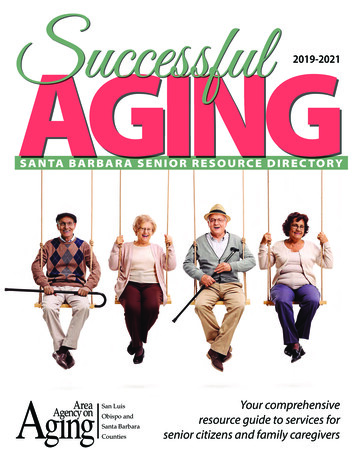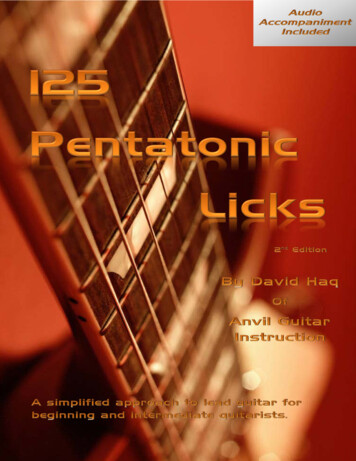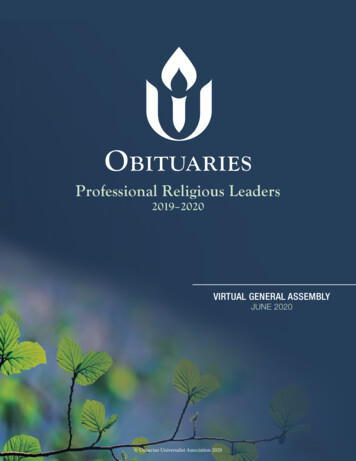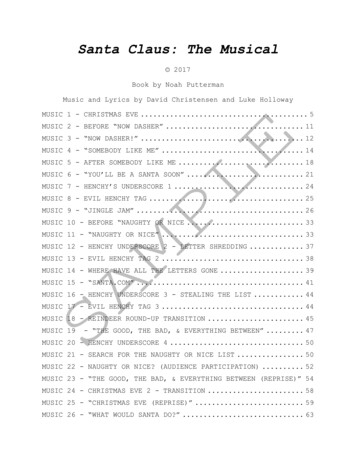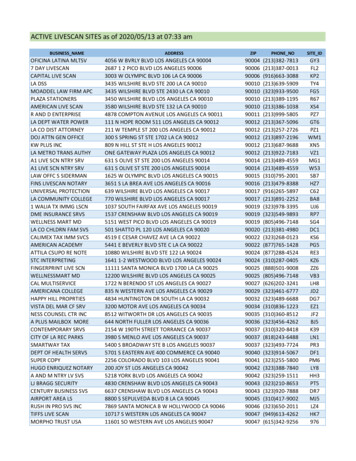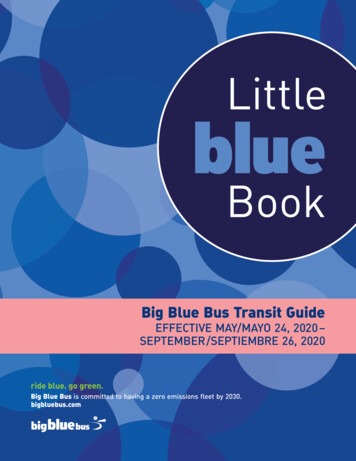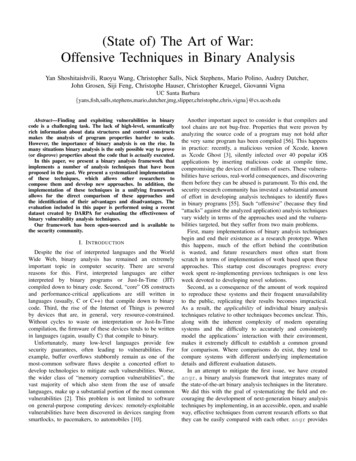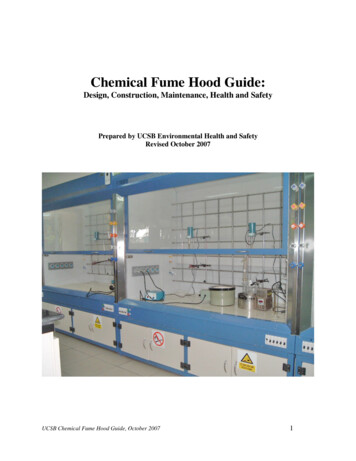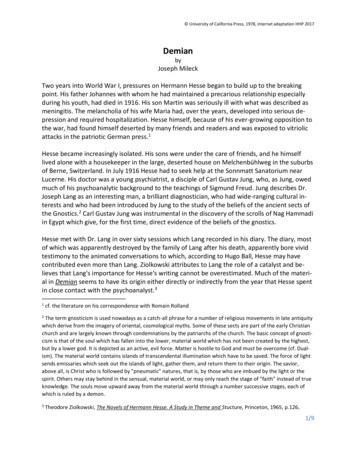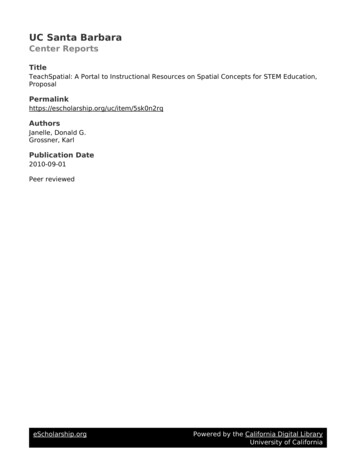
Transcription
UC Santa BarbaraCenter ReportsTitleTeachSpatial: A Portal to Instructional Resources on Spatial Concepts for STEM g/uc/item/5sk0n2rqAuthorsJanelle, Donald G.Grossner, KarlPublication Date2010-09-01Peer reviewedeScholarship.orgPowered by the California Digital LibraryUniversity of California
NSF DUE 1043777 NSDL Pathways, small grant (1 year) to DG Janelle (PI) and Karl Grossner(Research Associate), Unviversity of California, Santa Barbara. Funding as of 9 Sept 2010TeachSpatial: A Portal to Instructional Resources on SpatialConcepts for STEM EducationProject SummaryTeachSpatial is a small-grant NSDL Pathways proposal to extend and enhance an existing webportal (http://teachspatial.org) by providing guided access to digital resources that supportinstruction in spatial thinking skills within STEM subject courses. Spatial thinking has beendefined as “a constructive amalgam of three elements: concepts of space, tools of representation,and processes of reasoning . . . [that] can be learned and taught formally to students usingappropriately designed tools, technologies, and curricula” (NRC 2006).Instructors in numerous STEM fields have developed relevant digital teaching resources (coursesyllabi and units; exercises and linked datasets; examples and applications; rubrics forassessment) and many of these are registered in NSDL, but we lack the means to locate them inthis broader multidisciplinary context. The TeachSpatial project will develop proposed spatiallearning objectives for science instruction in grades 9–12, and for a college freshman seminar inspatial studies. It will then develop a research-based lexical framework mapping those objectivesto a classification schema for fundamental spatial concepts already in development. TheTeachSpatial portal will be extended as a NSDL Collection, organized around that framework,providing highly usable web access and feedback mechanisms.TeachSpatial will be based at the University of California, Santa Barbara, where previouslyNSF-funded programs—such as Spatial Perspectives on Analysis for Curriculum Enhancement(SPACE / PI: D. Janelle, http://www.csiss.org/space), the Center for Spatially Integrated SocialScience (CSISS / PI: M. Goodchild, http://www.csiss.org), and Spatial Thinking (PI: R.Golledge)—have provided innovative leadership in the development of geographic informationscience, spatial analysis, and a cross-disciplinary approach to understanding spatial ability,reasoning, and behavior.Intellectual Merit. Spatial thinking as a conceptual framework promotes new understandingsabout the spatial patterning of processes in the social, biological, and physical worlds as well asthe applications of spatial technologies to analyze, model, and visualize problems and researchoutcomes. Student progress and performance in numerous and varied STEM fields is thusstrongly tied to improving people’s ability to reason about spatial configurations and theirproperties (Newcombe 2006). The NRC report, Learning to Think Spatially (2006), documenteda lack of attention to spatial thinking in formal curricula, despite evidence that it is a primaryform of intelligence (Eliot 1987; Gardner 1993; Newcombe and Huttenlocher 2000), and calledfor “a national initiative to integrate spatial thinking into existing standards-based instructionacross the school curriculum, such as in mathematics, history, and science classes . . . to create ageneration of students who learn to think spatially in an informed way.” The TeachSpatialproject will support these goals by (1) identifying and formalizing connections between abstractgeometric concepts and their scientific applications, helping to illuminate a documented“educational blind spot” (NRC 2006) between science and math standards at the high school1
NSF DUE 1043777 NSDL Pathways, small grant (1 year) to DG Janelle (PI) and Karl Grossner(Research Associate), Unviversity of California, Santa Barbara. Funding as of 9 Sept 2010level; and (2) documenting a proposed baseline for mastery of spatial concepts by newundergraduates.Broader Impacts. TeachSpatial addresses a fundamental educational need to empower learnerswith concepts and tools for informed spatial reasoning for advancing science and improvingdecisions. Its focus on web technologies to deliver instructional resources will enhanceaccessibility for students to master and apply spatial concepts for discovery learning. TheTeachSpatial portal will enable instructors working as pioneers for spatial thinking to exchangeexperiences, pedagogical strategies, and evaluations of specific resources. A specialist workshopat an early stage of the project, with participants reflecting the diversity of perspectives on spatialthinking—including science education, cognitive psychology and spatial analysis technologies—will provide formative evaluation of this work in progress. The meeting is expected to helpsolidify the community of researchers and educators who view the explicit instruction of spatialthinking as both necessary and doable. We expect our proposed learning objectives to seed abroader discussion of their explicit integration in STEM educational standards and to motivatethe development of a follow-on NSDL Spatial Studies Pathway project in the near future.Project DescriptionIntroductionTeachSpatial is a small-grant NSDL Pathways proposal to extend and enhance an existing webportal (http://teachspatial.org) developed and hosted by the Center for Spatial Studies at theUniversity of California, Santa Barbara. TeachSpatial was launched in March 2009 with the dualobjectives of promoting the discussion of spatial literacy among researchers and educators, andproviding access to digital resources supporting the integration of spatial thinking into coursecurricula for STEM disciplines. This proposed project will develop the “resources” section of theTeachSpatial website as a managed NSDL Collection, organized according to a concept-basedframework currently in development. It will leverage advanced aspects of the NSDL DataRepository (NDR) content model, allowing users to discover and navigate between relatedresources in novel ways.Spatial thinking has been defined in the National Research Council report, Learning to ThinkSpatially (NRC 2006), as “a constructive amalgam of three elements: concepts of space, tools ofrepresentation, and processes of reasoning . . . [that] can be learned and taught formally tostudents using appropriately designed tools, technologies, and curricula.” Spatial thinking as aconceptual framework promotes new understandings about the spatial patterning of processes inthe social, biological, and physical worlds and the applications of spatial technologies to analyze,model, and visualize problems and research outcomes. The NRC report documented a lack ofattention to spatial thinking in formal curricula, despite evidence that it is a primary form ofintelligence, and called for “a national initiative to integrate spatial thinking into existingstandards-based instruction across the school curriculum . . . to create a generation of students2
NSF DUE 1043777 NSDL Pathways, small grant (1 year) to DG Janelle (PI) and Karl Grossner(Research Associate), Unviversity of California, Santa Barbara. Funding as of 9 Sept 2010who learn to think spatially in an informed way.” With several immediately useful products,TeachSpatial will take concrete steps to support such integration. Further, it is conceived as apilot for a larger NSDL Spatial Perspectives Pathway project in the near future, and willcontribute to framing that effort’s larger research agenda.Instructors in numerous disciplines have developed relevant resources (course syllabi and units;exercises and linked datasets; examples and applications; rubrics for learning assessment) andmany of these are registered in NSDL. However, we lack the means to locate them in the broadmultidisciplinary context of spatial thinking. This project will complete development of aresearch-based ontological framework and extensible lexicon that integrates multiple disciplinaryperspectives on fundamental spatial concepts, representational tools, and analytical methods.This classification schema will in turn be mapped to a set of proposed spatial learning objectives.We will then apply those subject metadata to existing resources dynamically in a new NSDLCollection, provide highly usable web access and feedback mechanisms, and evaluate itseffectiveness in the design and outcomes of a new college freshman seminar in spatial studies.RationaleSpatial intelligence and instructionSpatial intelligence is recognized as fundamental to the human activities of learning, discovery,and decision-making (Eliot 1987; Gardner 1993; Newcombe and Huttenlocher 2000). Achievingspatial literacy has nevertheless received little explicit attention in educational standards, ascompared to verbal and mathematical literacy. As reported in Learning to Think Spatially,although spatial concepts are central to four of the six basic National Science EducationStandards (NSES) themes—physical, life, Earth, and space sciences—spatial thinking andreasoning are not discussed explicitly (NRC 1996). In Principles and Standards for SchoolMathematics (NCTM 2000), spatial concepts likewise “pervade and permeate the detailedarticulation of what is expected of students,” (NRC 2006: 115) but they are explicit only withinthe geometry standards. The need for a coupling between related concepts in curricular standardsfor science and mathematics is asserted in the standards (NRC 1996: 214), but the manner ofcoupling is nowhere specified. The absence of formalized connections between abstractgeometric concepts and their scientific application constitutes an “educational blind spot,”wherein “spatial thinking is underappreciated and under-instructed in a systematic andcoordinated way” (Ibid: 131).The pervasiveness of spatial thinkingAn increased interest in spatial thinking (a “spatial turn”) has been recognized recently in severalsocial-science disciplines (e.g., see Hespanha et al. 2009; Janelle and Goodchild 2009;Goodchild and Janelle 2010; also, in sociology, see Lobao 2003; in demography, see Voss et al.2006; in history, see Knowles 2008), and Rita Colwell (2004) has envisioned a spatial portal as abasis for the general enrichment of science. Spatial perspectives have been especially important3
NSF DUE 1043777 NSDL Pathways, small grant (1 year) to DG Janelle (PI) and Karl Grossner(Research Associate), Unviversity of California, Santa Barbara. Funding as of 9 Sept 2010to archaeology, astronomy, ecology, and geography, but are now seeing significant researchapplications throughout the social, environmental, and health sciences. Butz and Torrey (2006),writing in Science, listed geographic information analysis as one of six innovation frontiers in thesocial sciences, and Norman Bradburn (2004, v) observes that “We are at the dawn of arevolution in a spatially oriented social science.” Examples of this “revolution” feature therelevance of spatial perspectives in both theory-driven research and in empirical analyses. Thus,in economics and related fields, the “New Economic Geography” (Krugman 1991, Fujita et al.1999) recognizes the importance of space as impeding the flow of information and affecting theoperation of markets. Spatial econometrics has emerged in the past decade as the focus ofworkshops, conferences, and scientific research of importance to economics, health andpopulation studies, and sociology (see Anselin et al. 2004). In the environmental fields, newspatial tools (e.g., the Global Positioning System, remote sensing, and GIS) are being used toimprove mapping and to track movement, and space and time are being introduced as explicitcomponents of ecological theory.Spatial thinking is equally important in physics, biology, and chemistry education, althoughperhaps less obvious because the scales of inquiry are “non-human.” The physical structure ofmaterial objects and the forces and processes underlying their transformations are inherentlyspatial. Mathewson (1999, 2005) has focused on the closely correlated “visual-spatial thinking”skills required for their analysis and for understanding a large proportion of scientific concepts,in describing a “visual core of science.”Although the Learning to Think Spatially report focused on the application of GeographicInformation Science (GIS) to help deliver instruction in spatial thinking, it fully documented thevalue of spatial thinking to science in general and its saliency in relationship to any space, fromthe cosmos to the human brain, and to virtually all disciplines regardless of scale, includingnanotechnology. Progress and performance in various science, technology, engineering, andmathematics (STEM) fields is strongly tied to improving people’s ability to reason about spatialconfigurations and their properties (Newcombe 2006).Statement of NeedThe Learning to Think Spatially report defined a far-reaching problem, and has provided avaluable foundation for proceeding towards solutions. Its recommendations spelled out the needfor a large-scale “systematic research program into the nature, characteristics and operations ofspatial thinking” and a “careful articulation of the links between spatial thinking standards andexisting disciplinary-based content standards” (pp. 232–233). Three narrower “primary needs”articulated in the recommendations were, to paraphrase:a. building and supporting a community of interestb. conceptualizing the integration of spatial thinking into existing STEM curriculac. disseminating relevant instructional resources4
NSF DUE 1043777 NSDL Pathways, small grant (1 year) to DG Janelle (PI) and Karl Grossner(Research Associate), Unviversity of California, Santa Barbara. Funding as of 9 Sept 2010These recommendations are being addressed to varied degrees by the Spatial Intelligence andLearning Center (SILC), a NSF-funded Science of Learning Center initiated in 2006 with twobroad goals: “to found an integrated, interdisciplinary field of spatial learning and to use theknowledge it produces to improve STEM education” (SILC 2010). SILC researchers haveproduced more than 80 publications to date. Separately, several individual researchers andsmaller groups have addressed spatial thinking particularly related to geography and earthscience education (including e.g., Golledge et al. 2008; Marsh et al. 2007; Jo and Bednarz 2009;Kastens and Ishikawa 2006; Lee and Bednarz 2009).The TeachSpatial project has taken parallel steps in supporting these distributed efforts. Thisproposal extends TeachSpatial, to begin consolidating our own and others’ work on conceptualframeworks (category “b” above) and by producing a preliminary solution for the discovery,organization, and dissemination of teaching resources (category “c”) in the most appropriatevenue, the National Science Digital Library (NSDL). We have discussed potential connections ofthis work to several SILC initiatives with its PI (N. Newcombe), and will continue to explorecollaborative possibilities. For example, we anticipate their participation in the specialistworkshops discussed in the Plan of Work, below.Although spatial perspectives are increasingly apparent in the published research literature, onlya small proportion of academic departments and instructional staff (outside of a few disciplines)have pioneered deliberate efforts to include spatial thinking and spatial computational reasoningas fundamental to undergraduate curricula. Even fewer have gone beyond the essentiallytechnological focus of GIS and spatial analysis to address the broader implications of spatialthinking in the scientific process.Many of the instructional materials necessary to explicitly address spatial thinking skills forcourses in physical, social, and environmental sciences already exist; unfortunately, they arescattered among instructors working largely in isolation from each other. While these pioneershave developed examples, modules, exercises, and assessment instruments, they lack the meansto share these resources within their own disciplines and have had little incentive to investigatetheir broader implementation in a multidisciplinary context. This project will help redress thisproblem by identifying and organizing the core concepts that highlight the value that spatialthinking and spatial methodologies bring to education at all levels, and by enabling the discoveryand rating of resources relevant to specific learning objectives.TeachSpatial work to dateThe TeachSpatial.org website was originally developed to implement suggestions from amultidisciplinary Symposium on a Curriculum for Spatial Thinking hosted by the University ofRedlands in June 2008 to discuss the merits and potential content of a general undergraduatecourse on spatial thinking. TeachSpatial.org was launched in March 2009 and has 210 registeredusers at this writing. A large majority of these are affiliated with higher education organizations.5
NSF DUE 1043777 NSDL Pathways, small grant (1 year) to DG Janelle (PI) and Karl Grossner(Research Associate), Unviversity of California, Santa Barbara. Funding as of 9 Sept 2010Although the site has not been publicized extensively, the number of visitors has been trendingupward, with approximately 100 unique visits per week in May 2010, for example. TheTeachSpatial web project objectives have been to:1. enumerate and define the core concepts of spatial thinking from multiple disciplinaryperspectives;2. develop and present schemas that interpret, synthesize, and model aspects of spatialthinking that draw on and interact with selected concepts;3. provide a venue for dialog within communities of interest, in individual and collectiveblogs and a discussion forum; and4. provide access to teaching and learning resources, organized by spatial concepts.Some of the efforts to date on objectives 1, 2, and 4 are described below. Despite considerablepositive feedback from colleagues at conferences and seminars, the online community has beenslow to develop. Our view is that a set of proposed learning objectives and a robust resourceportal are necessary precursors to greater online engagement.Spatial conceptsThe decision to organize resources around core spatial concepts reflecting multiple STEMperspectives motivated a project to discover what those concepts are, and to begin classifyingthem. A number of scholars have attempted to identify the fundamental concepts of spatialthinking, most notably from a geographic perspective. We harvested 185 concept terms from 20sources (see References, section B) in eight disciplines. Many terms are near-synonyms orotherwise closely related and in our digital compendium (www.teachspatial.org/concepts) wehave purposely not merged them, in order to maintain all definitional distinctions made by theirauthors. However, classification and further analysis meant removing redundancy—nine basiccategories emerged. All of the (now 132) concept terms could be intuitively placed in at least oneof these (Table 1); several realistically belong in more than one (secondary locations areitalicized).6
NSF DUE 1043777 NSDL Pathways, small grant (1 year) to DG Janelle (PI) and Karl Grossner(Research Associate), Unviversity of California, Santa Barbara. Funding as of 9 Sept 2010Table 1. Nine categories of spatial concepts (appearance in secondary category italicized)categorySpace‐time contextPrimitives of identityThe existence, nature andlabeling of things in the worldSpatial relationshipsComparative locations ofentities and their partsMeasurementof objects and of relationshipsand related issuesSpatial structuresas observed, and derived frommeasurement and analysisDynamicsDistinctly spatiotemporalconceptsRepresentationExternal tools; mentalprocessesTransformationson dataSpatial inferenceProducts of analysis andconclusions drawnSPATIAL CONCEPTSspace; space‐time; place; landscape; setting; reference frame;object view; field view; virtual reality; the void; figure‐groundidentity; object; field; attribute; category; classification;hierarchy; part; grouplocation; distribution; orientation; gradient; proximity;adjacency; connectivity; containment; part‐whole; center‐periphery; affinity; complement; symmetry; order; alignment;packing; polarity; chirality; separation; hierarchydistance; magnitude; density; shape; centrality; connectivity;dispersion; length; size; angle; area and volume; similarity;spatial sampling; modifiable areal unit; uncertainty; comparison;duration; frequency; gradient; accesspattern; structure; boundary; network; region; neighborhood;center; landmark; path; surface; area; container; group; folding;route; branching; conduit; coil; stratum; object; partflow; diffusion; spatial interaction; motion; navigation;attraction; force; counterforce; blockage; restraint removal;balance; event and process; sequence; chaos; energetics;potential; enablement; deformation; cycle; duration; frequency;pathrepresentation; map; perspective; cognitive map; routeperspective; survey perspective; point; line; polygon; grid;coordinate system; units; object location recallscale; spatial interpolation; spatial integration (overlay); buffer;dimensional transformation; profile; structuring; grain; time cost;space as time; map projectionspatial dependence; spatial heterogeneity; distance decay; arealassociation; spatial model; competition for space; spatialprobability; aura; congruence; similarity; accessThere are significant relationships between these concepts apart from shared membership in oneof nine such “bins,” and we have begun exploring and visualizing these (Figure 1). In theLearning to Think Spatially report, several definitional constructs were put forward, and we jointwo of these to form the core of an integrative matrix.7
NSF DUE 1043777 NSDL Pathways, small grant (1 year) to DG Janelle (PI) and Karl Grossner(Research Associate), Unviversity of California, Santa Barbara. Funding as of 9 Sept 2010The first, Elements of Spatial Thinking, includes:a. concepts of space,b. tools of representation, andc. processes of reasoningThe second, Component Tasks of Spatial Thinking, includes:a. extracting spatial structures,b. performing spatial transformations, andc. drawing functional inferencesWe judge the three “Component Tasks” to be natural subdivisions of the third “Element,”processes of reasoning. Furthermore, many of the concept terms in our developing lexicon havemultiple senses, which can be characterized as being “internal” (mental or cognitive) or“external” (e.g., computational). Finally, a number of the spatial concepts deemed fundamentalby our 20 sources refer to analytical methods, or means, for extracting structures, performingtransformations, calculating inference, and so forth. The harvested spatial concepts fit within anexpanded matrix as depicted with some difficulty in the two-dimensional Figure 1. The properorganizational structure is undoubtedly a multi-graph and one key product of this proposedproject will be a graph-based formalization that can be navigated in the NSDL object metadataframework. Note that the “Means” column for the Reasoning/Internal section contains relevantnon-spatial terms added for clarity.8
NSF DUE 1043777 NSDL Pathways, small grant (1 year) to DG Janelle (PI) and Karl Grossner (Research Associate), Unviversity ofCalifornia, Santa Barbara. Funding as of 9 Sept 2010Figure 1. Elements and Component Tasks of Spatial Thinking9
NSF DUE 1043777 NSDL Pathways, small grant (1 year) to DG Janelle (PI) and Karl Grossner(Research Associate), Unviversity of California, Santa Barbara. Funding as of 9 Sept 2010Locating and measuring spatial analytic reasoning in research abstractsThe Center for Spatial Studies has undertaken to measure the density of spatial analytic terms intwenty-one years of NSF research abstracts computationally, with a novel Index of Spatiality(IOS) measure of weighted term density, grounded in an empirical survey with humanrespondents (Grossner and Montello 2010).IOSNSF DIRECTORATE0.033MPS – Mathematical andPhysical Sciences0.030GEO – Geosciences0.0280.028CISE – Computer andInformation Science andEngineeringOD – Office of the Director0.027ENG – Engineering0.026OPP – Office of PolarProgramsBIO – Biological Sciences0.0210.0200.020SBE – Social, Behavioral andEconomic SciencesEHR – Education and HumanResourcesFigure 2. Relative “spatial term density” in NSF research award abstracts averaged over the period,1988–2009. Darker tones indicate higher values. Rectangle size corresponds to funding level.Term density values ranged from 0.00 to 0.61. These were averaged across NSF Directorates andDivisions for the 21-year period, as summarized and visualized in Figure 2. Our results confirmthat spatial analytic reasoning is pervasive across many STEM fields. While high values wereexpected for the geosciences (GEO), we did not expect those for the mathematical and physicalsciences (MPS) to be higher (mean IOS of 0.033 vs. 0.030), or those for the computationalsciences (CISE) to be nearly equal (IOS 0.028). The high values for Physics (PHY, 0.031) andMath (DMS, 0.050) reflect the dominance of reasoning about what the NRC report calls the“geography of our physical spaces . . . scientific understanding of the nature, structure, andfunction of phenomena that range from the microscopic to the astronomical scales” (2006: 30).Given the broad application of spatial thinking in STEM fields, one might hope to see morespatial language in education-related projects (EHR, 0.020).10
NSF DUE 1043777 NSDL Pathways, small grant (1 year) to DG Janelle (PI) and Karl Grossner(Research Associate), Unviversity of California, Santa Barbara. Funding as of 9 Sept 2010These automated measures of spatiality were found to correlate well with human judgments(r2 0.551). As part of the proposed TeachSpatial project we will seek to improve the IOSmeasure by incorporating collocation counts to disambiguate terms, and by additional weightingbased on term and term-pair dispersion within documents. This investigation is a step towardbetter understanding the role of spatial thinking in scientific research, and how judgments ofspatiality are made. The IOS measure can be applied to any text corpus, and we will use it tohelp locate research and educational resources that are “high-spatial.”Learning modules by spatial conceptTo investigate how instructional units for spatial thinking skills might best be organized, theCenter for Spatial Studies has begun creating “learning modules” centered on 13 core spatialconcepts: boundary, direction, distance, location, map, neighborhood and region, network,objects and fields, overlay, pattern, scale, spatial dependence, and spatial heterogeneity. Thesepreliminary efforts have confirmed that locating relevant digital resources is problematic—particularly for exemplar material outside the fields of geography and Earth sciences. The workis constrained by the absence of a set of learning objectives derived in a systematic fashion fromexisting science and math content standards. The proposed project will provide these, andformalize their mapping to a comprehensive spatial concept taxonomy, to enable efficient, semiautomated discovery of relevant existing resources within the large repository that is NSDL.Plan of WorkThe primary goal of the TeachSpatial project is the development of a web portal to NSDLresources that support instruction in spatial thinking learning objectives for STEM fields. Thereis not yet a consensus on what those learning objectives should be. We will organize the portal’sbrowsing and search facilities around an ontological framework mapping fundamental spatialconcepts to the explicit and implicit spatial learning objectives discovered within three existingcontent standards for science and math: National Science Education Standards (NRC 1996)Benchmarks for Science Literacy (AAAS 1994)Principles and Standards for School Mathematics (NCTM 2000)This strategy entails further delineation of the missing math-science connections reported in(NRC 2006) as discussed earlier. We expect the portal to be immediately useful for the design ofinstruction, and to help inform future discussion of grade- and development-level standards forspatial literacy.Toward those ends the project will:1. Complete the systematic identification and classification of spatial concept terms and simplelexical relationships between them (broader-term, narrower-term, used-for, etc.).11
NSF DUE 1043777 NSDL Pathways, small grant (1 year) to DG Janelle (PI) and Karl Grossner(Research Associate), Unviversity of California, Santa Barbara. Funding as of 9 Sept 20102. Locate the application of spatial concepts in existing educational standards and STEMresearch projects, using both automated natural language processing and manual methods.The Index of Spatiality (IOS) algorithm will be refined, as discussed earlier.3. Develop a preliminary (“straw”) set of spatial thinking learning objectives for grade levels9–12 and 13–16, drawing on the work in Step 2 above, our own experience in the SPACE 1and SCALE 2 projects, and recent research in geospatial education (e.g., Golledge et al. 2008;Marsh et al. 2007; Jo and Bednarz 2009; Lee and Bednarz 2007). The work of Steps 2 and 3will be refined in the course of a specialist workshop hosted at an early stage of this project(discussed in the following section).4. Develop a simple graph-based formalization, compatible with the NSDL metadata model,representing the explicit connections between spatial concepts, STEM content standards, andthe preliminary spatial thinking learning objectives. This will further clarify the inferredrelationships between the concepts themselves and support a flexible browsing interface.5. Build a web interface to existing resources as a managed NSDL Col
Learning to Think Spatially, although spatial concepts are central to four of the six basic National Science Education Standards (NSES) themes—physical, life, Earth, and space sciences—spatial thinking and reasoning are not discussed explicitly (NRC
